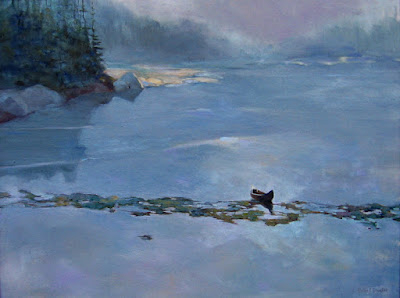Plein air painters may not often break a sweat, but we’re exposed to the same environmental stresses as athletes.
 |
|
Niagara Falls, pastel, Carol L. Douglas.
|
Yesterday, I wrote that when my painting goes south, I ask myself basic questions about my process and the ergonomics of painting. Then I proceeded to ignore my own advice. I felt terrible all day, fighting a headache and fatigue. At 2 PM I took aspirin with a cup of coffee and tucked myself in my bed for a few moments to wait for them to work. At dinnertime, I awoke with a start when my friend Barb hallooed from my kitchen. I’d missed an appointment and wasted an afternoon.
I wasn’t particularly overtired; I was thirsty. Proper hydration is as much a priority for plein airpainters and long-distance travelers as it is for athletes. Although the results of drinking insufficient water are less spectacular for us, they’re no less real.
 |
|
Headwaters of the Hudson, oil on canvas, Carol L. Douglas.
|
I often bring my water bottle with me, only to use it as a wind-weight on my easel or for wetting paints. Why am I so resistant to drinking in the field?
The problem isn’t the opportunity to drink fluids; it’s the opportunity to expel them. Even if you’re accustomed to peeing in the woods, it isn’t always possible. Le pipi rustique is simply more difficult for women than it is for men, and I subconsciously avoid it.
As a teacher, I’m mindful about not putting my students in situations where there aren’t bathrooms. As a painter, I’m more willing to go off the beaten path.
 |
|
Curve on Goosefare Brook, 8X6, Carol L. Douglas.
|
The same is true with being on the road. Beverage options are limited to coffee, water, or sodas. Rest stops are few and far between, and stopping takes time. Fast food, should you be unlucky enough to have to eat it, is loaded with sodium. While one could prepare food and beverages at home, it’s a third level of packing, on top of equipment and clothing. I never seem to have the time to do it.
It’s true that the benefits of water have been oversoldin recent years. Still, water is important, and we suffer when we don’t drink it. Our bodies are about 60% water. It plays a role in every major system. Cells that don’t maintain the proper electrolyte balance shrivel, resulting in muscle fatigue. Water helps our kidneys excrete toxins and keeps our bowels happy. It lubricates our joints and regulates our body temperature. It helps transport nutrients.
 |
|
Kaaterskill Falls, by Carol L. Douglas.
|
Plein air painters may not often break a sweat, but we’re exposed to the same environmental stresses as athletes: heat, cold, and wind. Hiking with our kits, setting up, and tearing down are physically demanding. If we’re not hydrated, we can’t perform at our highest level.
So I’m resolved—once again—to drink more fluids, even when it’s difficult. Now, if anyone has suggestions on how to succeed at that, I’d love to hear them.
An addendum: I had an eye exam this afternoon, and I suffer from a common ailment called epithelial basement membrane dystrophy. That’s a fancy way of saying “dry eyes,” and it just underscores the need to drink more water.
